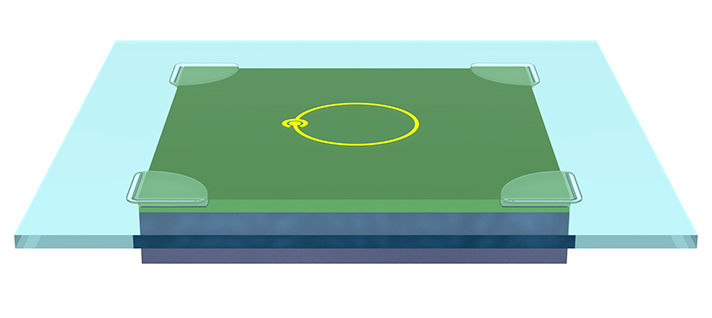Acoustic resonator device paves the way for better communication
Yale researchers have developed a high-frequency version of a device known as an acoustic resonator that could advance the field of quantum computing and information processing.

Schematic of the piezo-electromechanical device. A superconducting resonator (in yellow) is fabricated in a niobium titanium nitride film on a sapphire substrate. The resonator is flipped and suspended on top of an acoustic resonator, which consists of a thin aluminum nitride layer (green) deposited on a thick silicon substrate.
Yale University
Hong Tang, Yale’s Llewellyn West Jones Jr. Professor of Electrical Engineering & Physics, and his research team, accomplish this with what’s also known as a piezo-optomechanical device. It achieves what is known as “a strong coupling” between two systems: a superconducting microwave cavity and a bulk acoustic resonator system.
With a strong coupling, the device achieves an exchange of energy and information between the microwave and mechanical resonator systems in a way that exceeds the dissipation — or diminishing energy — of each of the individual systems. That way, information doesn’t get lost.
A unique feature of the system is that it operates at the very high frequency of 10 gigahertz. An advantage of a high-frequency system is that it allows for a high signal-processing speed, noted Xu Han, a Ph.D. student in Tang’s lab and lead author of the study. “For example, you can convey the same amount of information or message in a shorter time,” Han said.
Another advantage is that the high frequency makes it easier to observe quantum phenomena in experiments. In lower frequency devices, the system has to be cooled to extreme temperatures to overcome thermal noise, which comes from random vibrations from the environment that scramble the signal.
One of the potential applications, Han said, is information storage. “If you have a good coupling and exchange between the systems, then you can store information from the microwave domain in the mechanical domain,” he said.
Although the experiments weren’t conducted under quantum conditions, the researchers note that the high-frequency piezo-electromechanical device is compatible with superconducting qubits — the unit of information analogous to digital bits in conventional computing. That potentially could mean an important step towards hybrid quantum systems, which bridge the world between classical and quantum mechanics, they said.
Han said he is currently building on the technology to develop a device that uses the mechanical system to convert information from the microwave domain to the optical.
“If you want to transmit the information signal, you have to use optics, because optical fiber has very low loss over a long distance,” he said.
Original publication
Other news from the department science

Get the chemical industry in your inbox
By submitting this form you agree that LUMITOS AG will send you the newsletter(s) selected above by email. Your data will not be passed on to third parties. Your data will be stored and processed in accordance with our data protection regulations. LUMITOS may contact you by email for the purpose of advertising or market and opinion surveys. You can revoke your consent at any time without giving reasons to LUMITOS AG, Ernst-Augustin-Str. 2, 12489 Berlin, Germany or by e-mail at revoke@lumitos.com with effect for the future. In addition, each email contains a link to unsubscribe from the corresponding newsletter.




























































